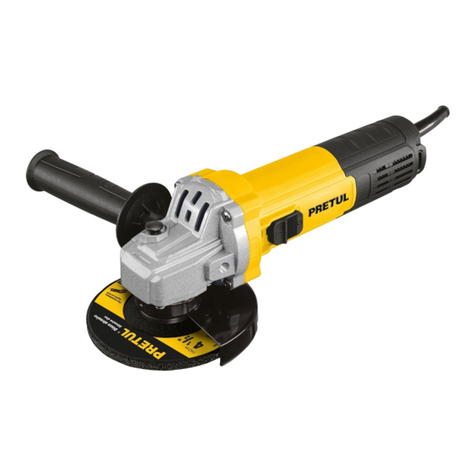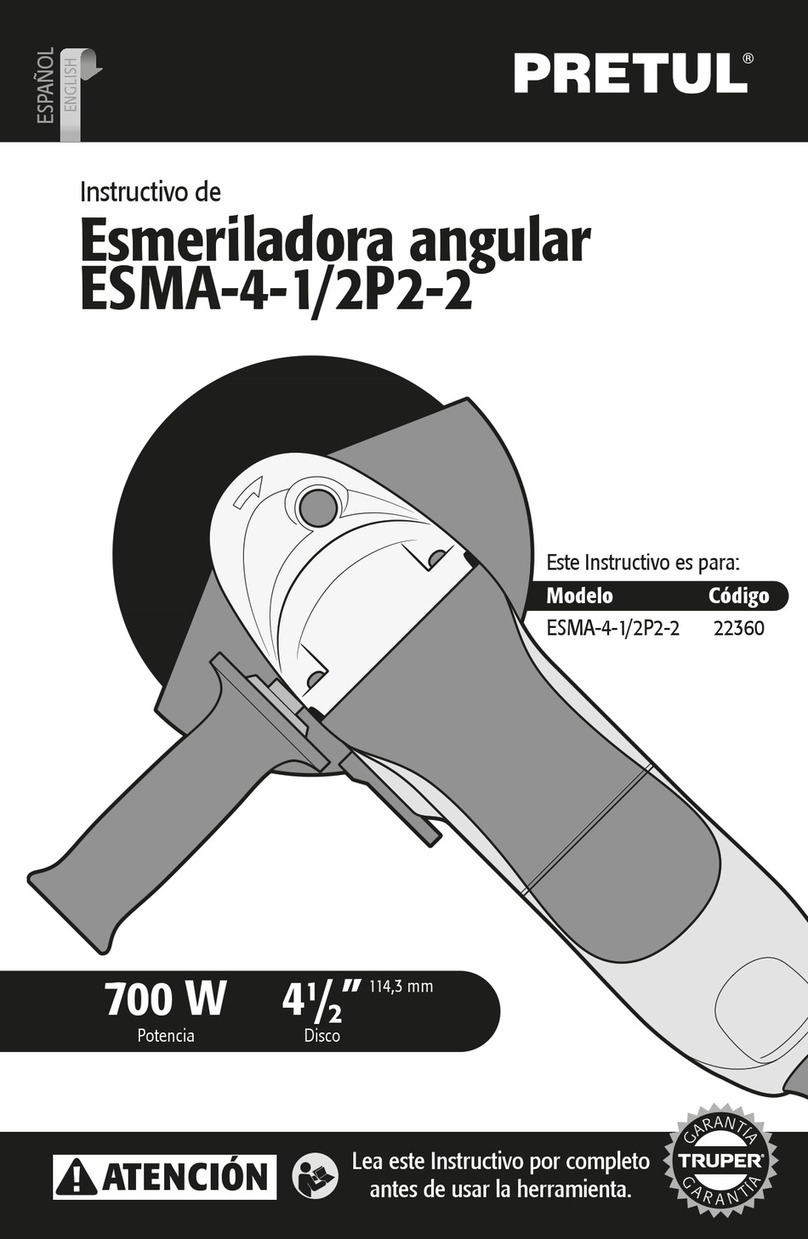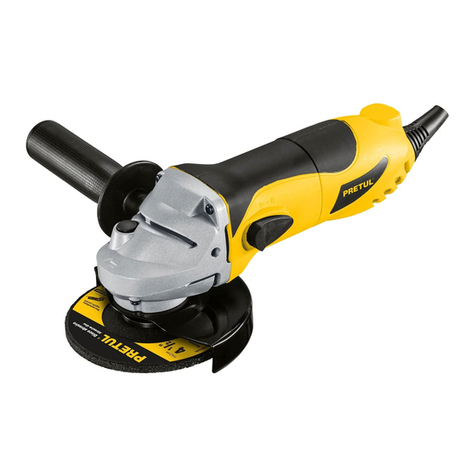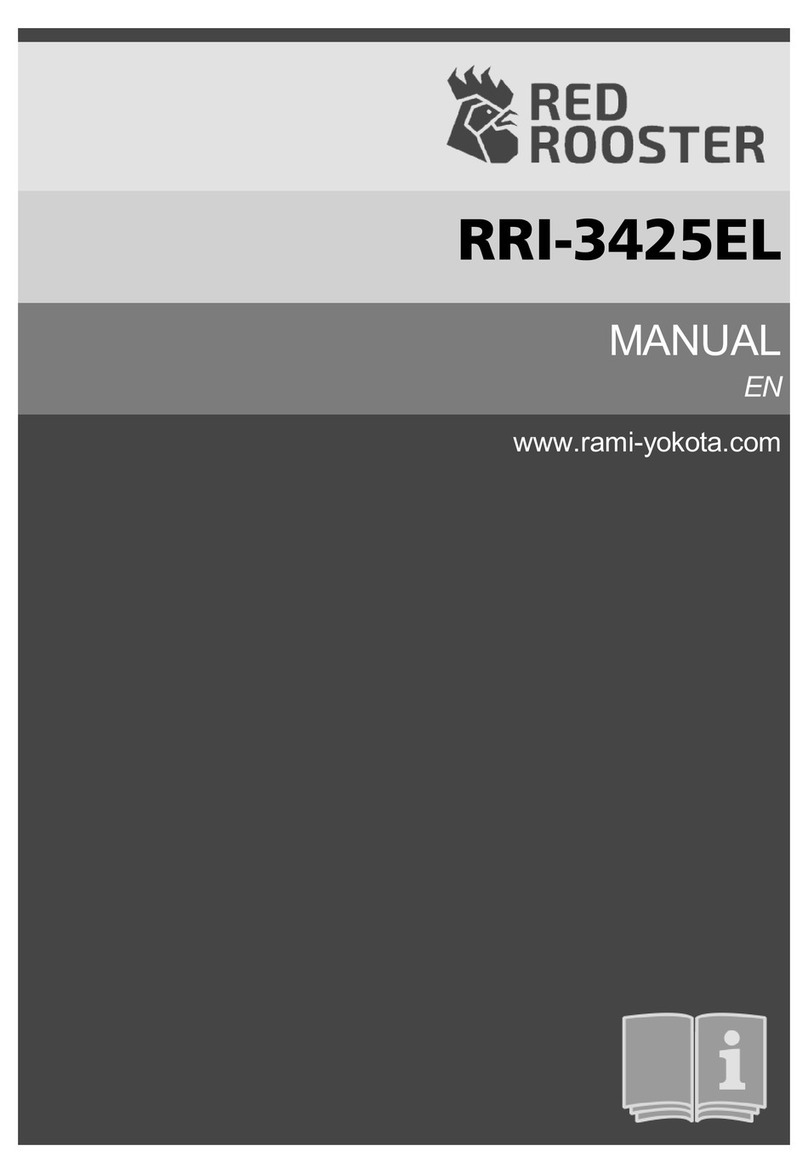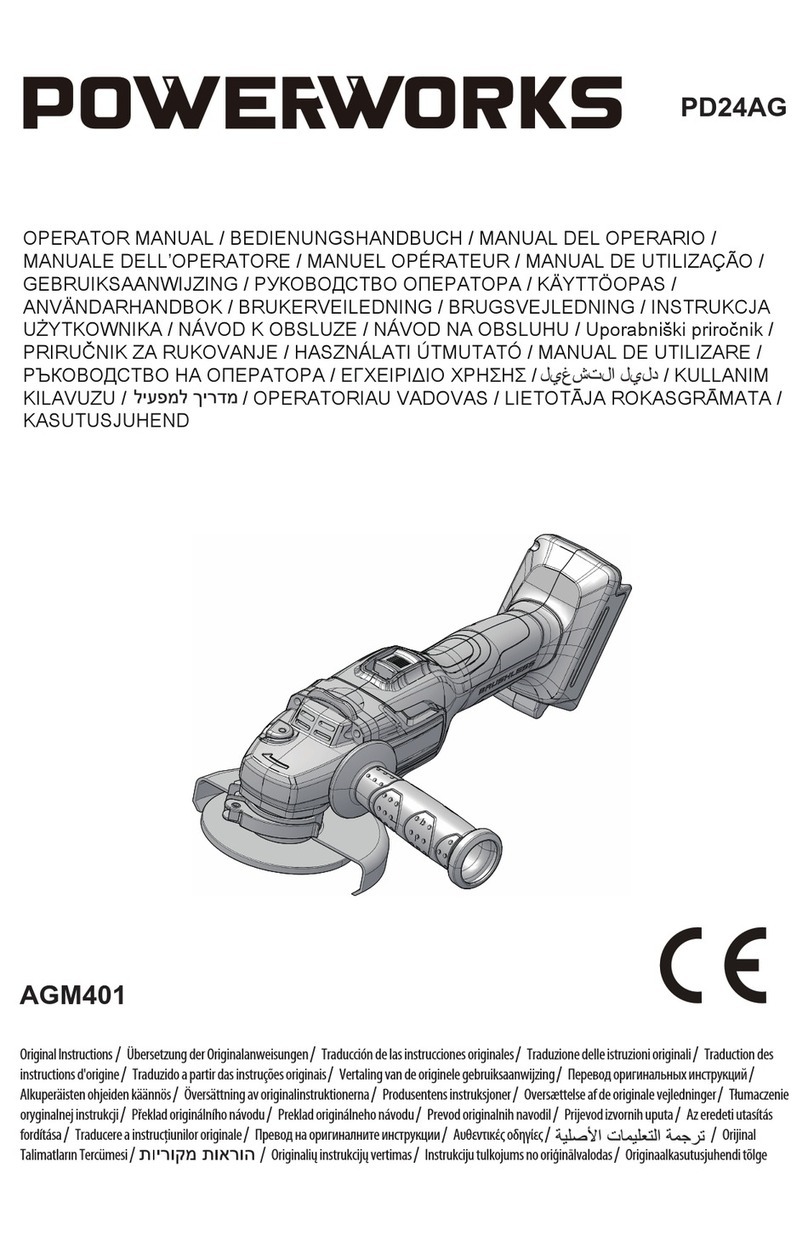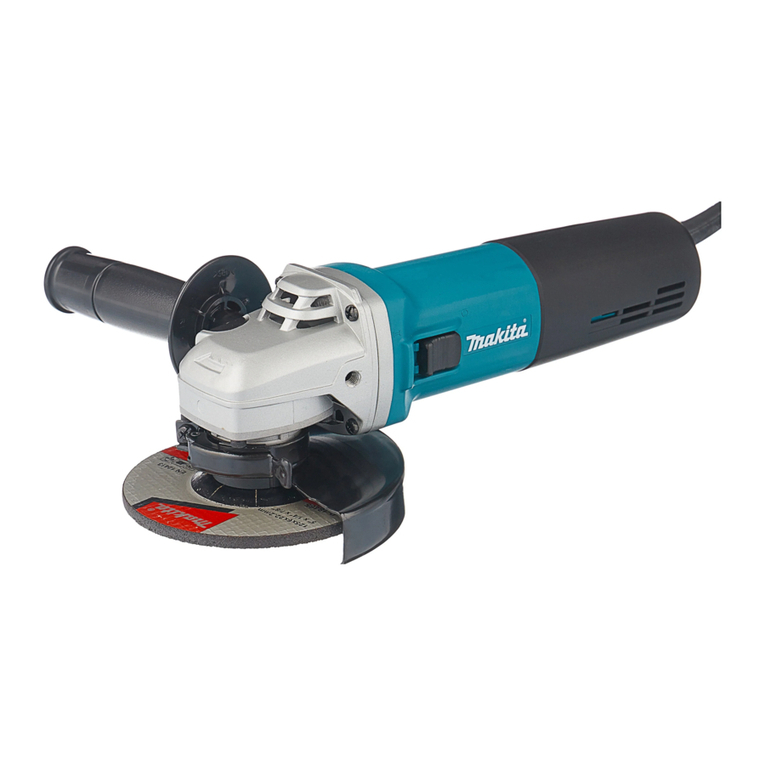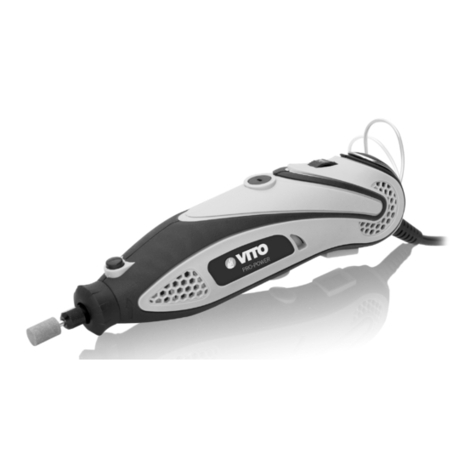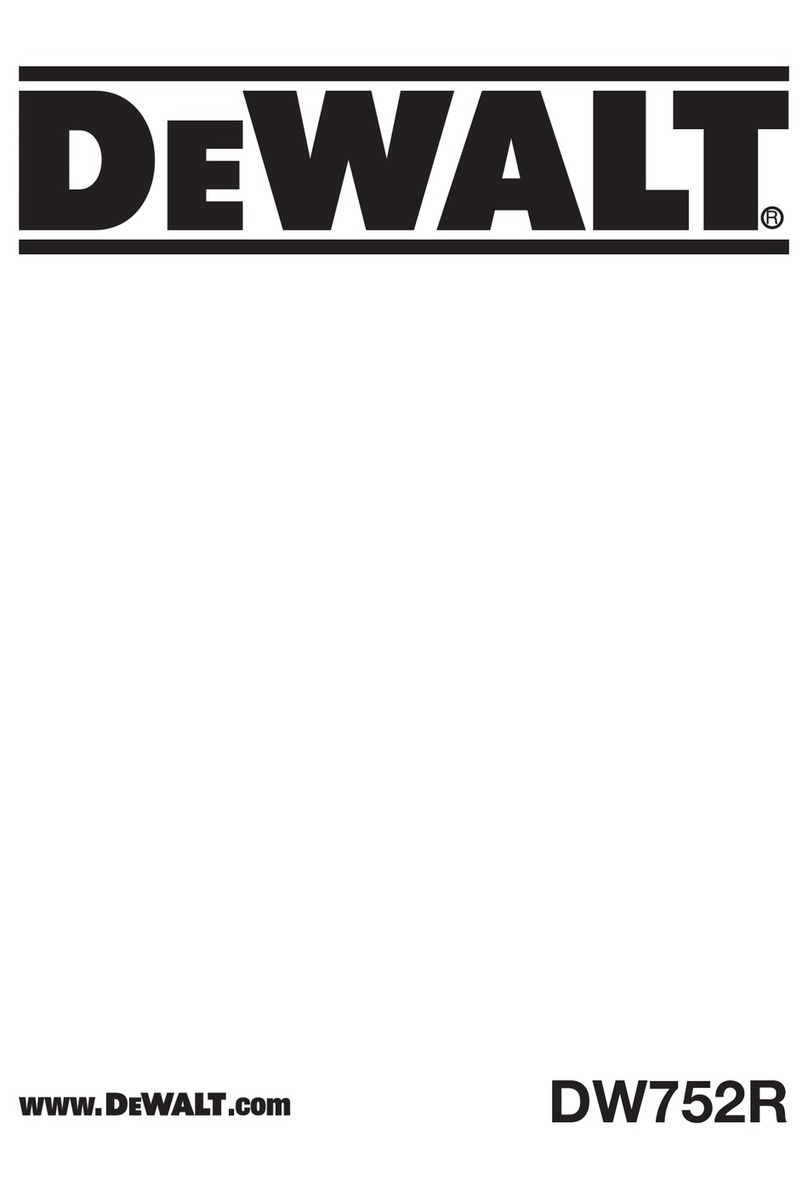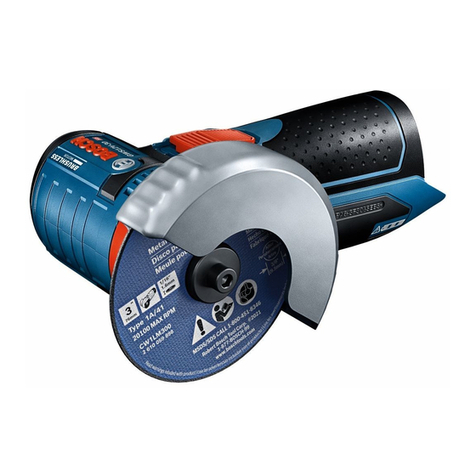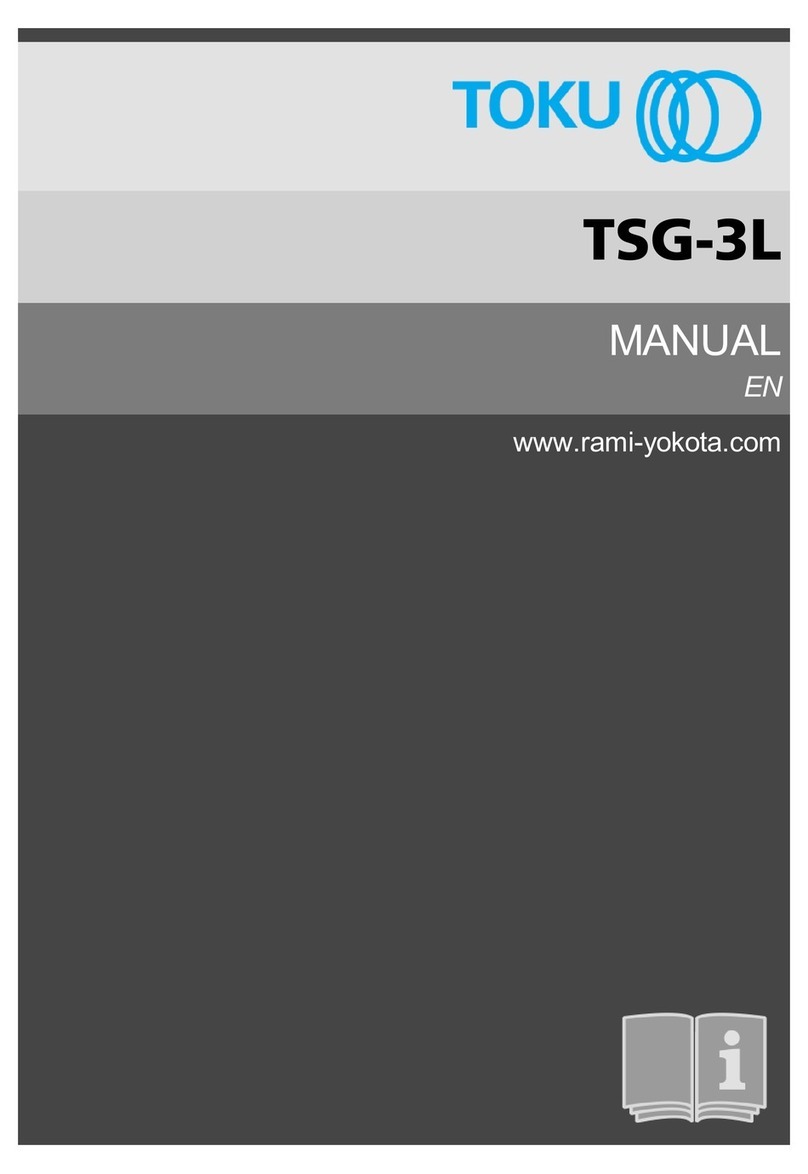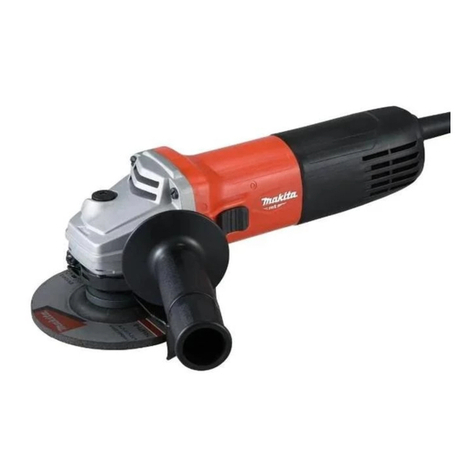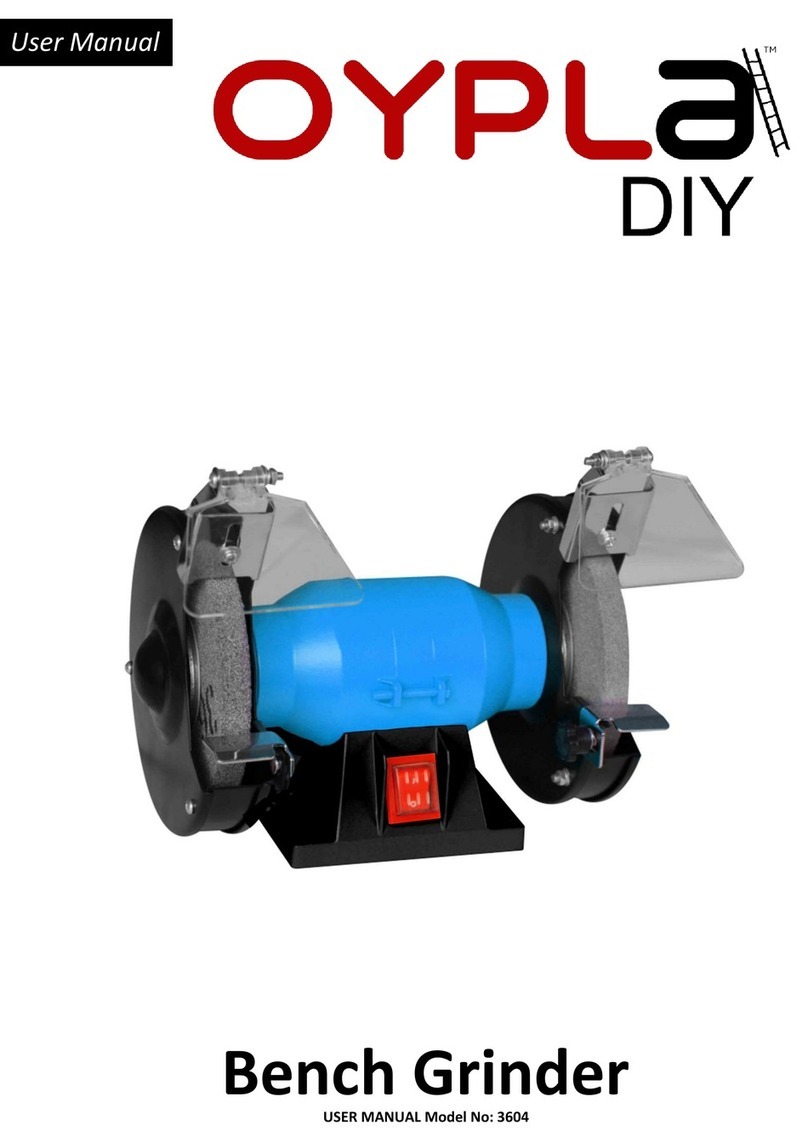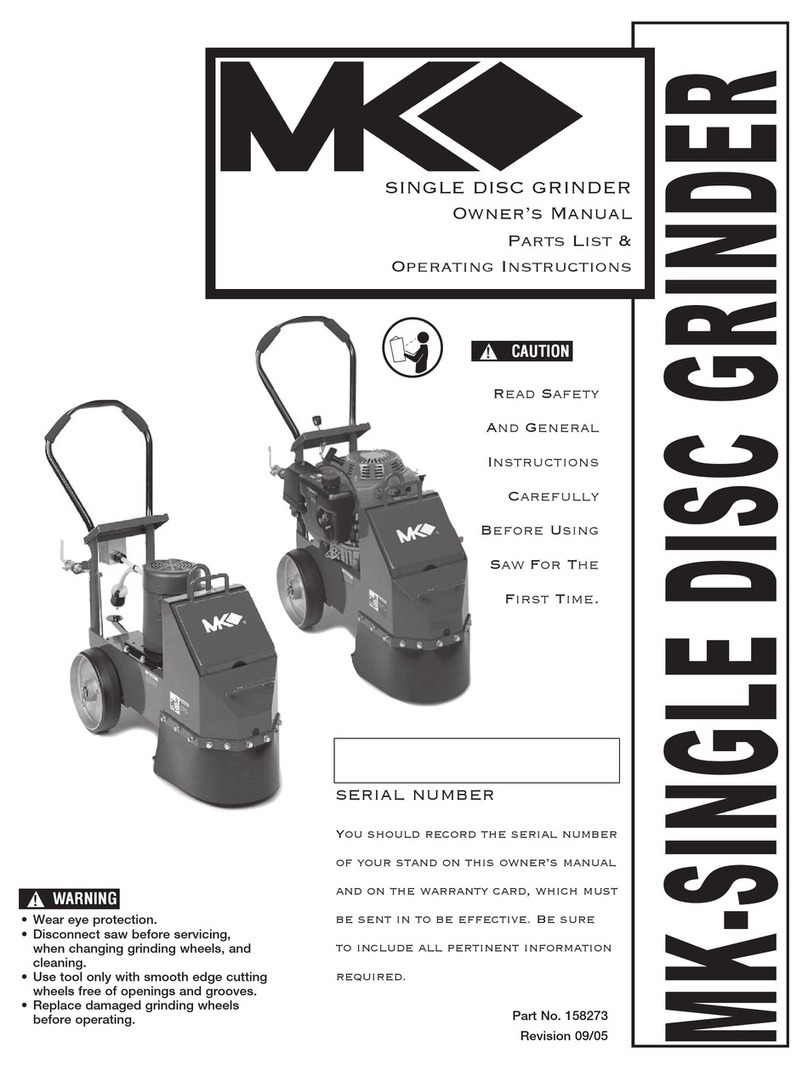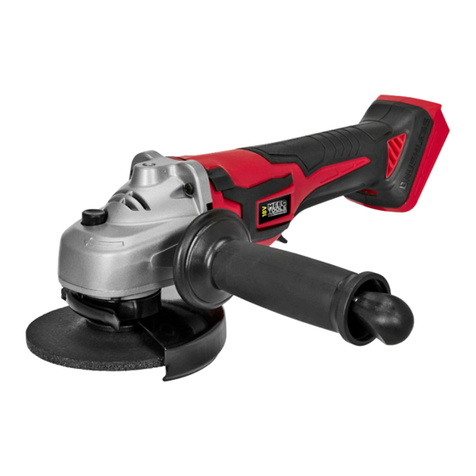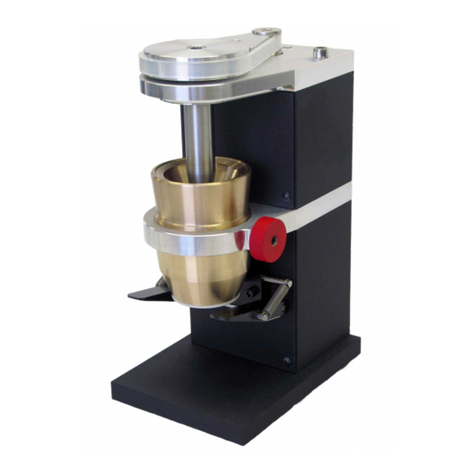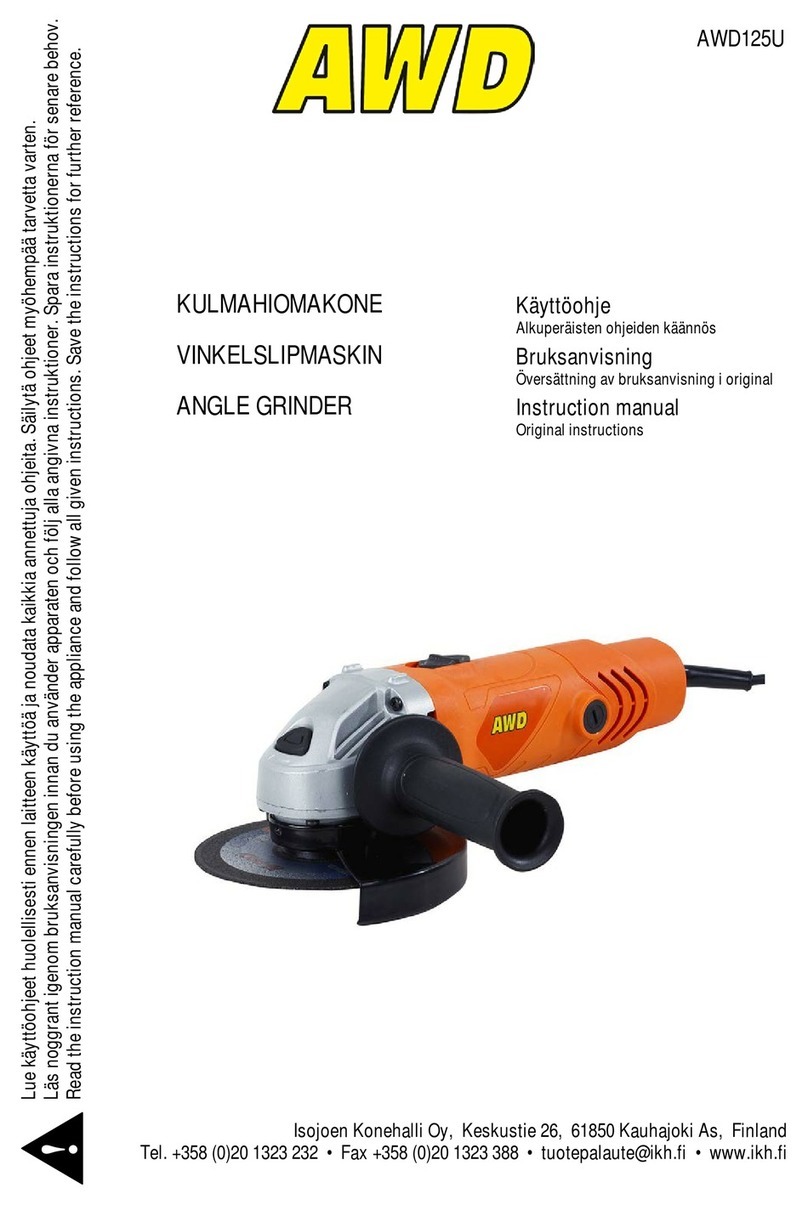PRETUL EBA-5P User manual

Instructivo de
Esmeril
de banco
EBA-5P
Modelo Código
EBA-5P
Este Instructivo es para:
29994
125 mm
Ruedas abrasivas
5”
ESPAÑOL
ENGLISH
Lea este Instructivo por completo
antes de usar la herramienta.
ATENCIÓN

EBA-5P
EBA-5P
Í
ndice
2
Especificaciones técnicas
Requerimientos eléctricos
Advertencias Generales de Seguridad
para herramientas eléctricas
Advertencias de Seguridad
para uso de esmeriles de banco
Partes
Montaje
Puesta en marcha
Mantenimiento
Notas
Centros de Servicio Autorizados
Póliza de Garantía
Guarde este Instructivo para futuras referencias.
Los gráficos de este Instructivo son para
referencia, pueden variar del aspecto real de la
herramienta.
3
3
4
5
6
7
8
9
Para poder sacar el máximo
provecho de la herramienta,
alargar su vida útil, hacer válida
la garantía en caso de ser
necesario y evitar riesgos o
lesiones graves, es fundamental
leer este Instructivo por
completo antes de usar la
herramienta.
ATENCIÓN
ESPAÑOL
10
11
12

3
EBA-5P
29994
125 mm (5”)
Clase I
60 Hz
Esmeril de banco
18 AWG X 3 C
con temperatura de aislamiento de 105 °C
0,9 A
120 W (1/6 Hp)
30 minutos de trabajo por 15 minutos de descanso. Máximo 6 horas diarias
Código
Descripción
Diámetro de ruedas
Tensión
Frecuencia
Corriente
Potencia
3 450 r/min
Velocidad
Ciclo de trabajo
Conductores
Aislamiento
127 V
Especificaciones técnicas
El cable de alimentación tiene sujeta-cables tipo: Y
La clase de construcción de la herramienta es: Aislamiento básico.
La clase de aislamiento térmico de los devanados del motor: Clase B
Requerimientos eléctricos
Si el cable de alimentación se daña, éste debe ser reemplazado por el fabricante o Centro de Servicio
Autorizado , con el fin de evitar algún riesgo de descarga o accidente considerable.
La construcción del aislamiento eléctrico de esta herramienta es alterado por salpicaduras o
derramamiento de líquidos durante su operación. No la exponga a la lluvia, líquidos y/o humedad.
Antes de obtener acceso a las terminales, todos los circuitos de alimentación deben ser desconectados.
ADVERTENCIA
ADVERTENCIA
ESPAÑOL
Al operar herramientas eléctricas en exteriores, utilice una extensión
aterrizada marcada como “Uso exterior” marca . Estas extensiones son
especiales para el uso en exteriores y reducen el riesgo de sufrir una descarga eléctrica.
ADVERTENCIA
de 0 A hasta 10 A
de 10 A hasta 13 A
de 13 A hasta 15 A
de 15 A hasta 20 A
18 AWG
16 AWG
14 AWG
8 AWG
16 AWG
14 AWG
12 AWG
6 AWG
3 (uno a tierra)
de 1,8 m a 15 m | mayor de 15 m
Capacidad en
Amperes Número de
conductores Calibre de extensión
En el caso de fallas o averías, la conexión a tierra provee una
trayectoria con resistencia mínima para la corriente eléctrica, lo que reduce el riesgo de
sufrir una descarga eléctrica. Esta herramienta está equipada con un cable eléctrico que
tiene un conductor a tierra y una clavija con conexión a tierra. La clavija debe estar
conectada a una entrada que se encuentre instalada y aterrizada de acuerdo con todos
los códigos locales.
ADVERTENCIA
Al usar un cable de extensión, asegúrese de usar el calibre
suficiente para transportar la corriente que consumirá su herramienta. Un cable de
un calibre inferior ocasionará caídas de tensión en la línea, teniendo como resultado pérdida de potencia y sobrecalentamiento
del motor. La siguiente tabla muestra el tamaño correcto que debe usarse dependiendo de la longitud del cable y de la
capacidad de amperes indicada en la placa de datos de la herramienta. Si tiene dudas use el siguiente calibre más alto.
ATENCIÓN

4
Advertencias generales de seguridad
para herramientas eléctricas
ESPAÑOL
Área de trabajo
Mantenga el área de trabajo limpia y bien iluminada.
Las áreas desordenadas y obscuras son propensas a accidentes.
No maneje la herramienta en ambientes explosivos, como en
presencia de líquido, gas o polvo inflamables.
Las herramientas eléctricas producen chispas que pueden encender
material inflamable.
Mantenga alejados a los niños y curiosos cuando opere la
herramienta.
Las distracciones pueden hacer que pierda el control.
Seguridad eléctrica
La clavija de la herramienta debe coincidir con el tomacorrien-
te. Nunca modifique una clavija. No use ningún tipo de
adaptador para clavijas de herramientas puestas a tierra.
Clavijas modificadas y enchufes diferentes aumentan el riesgo de
choque eléctrico.
Evite el contacto del cuerpo con superficies puestas a tierra
como tuberías, radiadores, cocinas eléctricas y refrigeradores.
Hay un mayor riesgo de choque eléctrico si el cuerpo está puesto a tierra.
No exponga la herramienta a la lluvia o condiciones de humedad.
El agua que ingresa en la herramienta aumenta el riesgo de choque eléctrico.
No fuerce el cable. Nunca use el cable para transportar,
levantar o desconectar la herramienta. Mantenga el cable
lejos del calor, aceite, orillas afiladas o piezas en movimiento.
Los cables dañados o enredados aumentan el riesgo de choque eléctrico.
Cuando maneje una herramienta en exteriores, use una
extensión especial para uso en exteriores.
El uso de una extensión adecuada para exteriores reduce el riesgo de choque
eléctrico.
Si el uso de la herramienta en un lugar húmedo es inevitable,
use una alimentación protegida por un interruptor de circuito
de falla a tierra (GFCI).
El uso de un GFCI reduce el riesgo de choque eléctrico.
Seguridad personal
Esté alerta, vigile lo que está haciendo y use el sentido común
cuando maneje una herramienta. No la use si está cansado o
bajo la influencia de drogas, alcohol o medicamentos.
Un momento de distracción mientras maneja la herramienta puede
causar un daño personal.
Use equipo de seguridad. Use siempre protección para los ojos.
El uso de equipo de seguridad como lentes de seguridad, mascarilla antipolvo,
zapatos antideslizantes, casco y protección para los oídos en condiciones
apropiadas, reduce de manera significativa los daños personales.
Evite arranques accidentales. Asegúrese de que el interruptor
está en posición “apagado” antes de conectar a la fuente de
alimentación y/o a la batería o transportar la herramienta.
Transportar herramientas eléctricas con el dedo sobre el interruptor o
conectar herramientas eléctricas que tienen el interruptor en posición de
“encendido” puede causar accidentes.
Retire cualquier llave o herramienta de ajuste antes de arrancar
la herramienta eléctrica.
Las llaves o herramientas que quedan en las partes rotativas de la
herramienta pueden causar un daño personal.
No sobrepase su campo de acción. Mantenga ambos pies bien
asentados sobre el suelo y conserve el equilibrio en todo
momento.
Esto permite un mejor control de la herramienta en situaciones inesperadas.
Vista adecuadamente. No vista ropa suelta o joyas. Mantenga su
pelo, su ropa y guantes alejados de las piezas en movimiento.
La ropa o el pelo sueltos o las joyas pueden quedar atrapados en
las piezas en movimiento.
En caso de contar con dispositivos de extracción y recolección
de polvo conectados a la herramienta, verifique sus conexiones
y úselos correctamente.
El uso de estos dispositivos reduce los riesgos relacionados con el polvo.
Uso y cuidados de la herramienta
No fuerce la herramienta. Use la herramienta adecuada para el
trabajo a realizar.
La herramienta adecuada hace un trabajo mejor y más seguro cuando
se usa al ritmo para el que fue diseñada.
No use la herramienta si el interruptor no funciona.
Cualquier herramienta eléctrica que no pueda encenderse o
apagarse es peligrosa y debe repararse antes de ser operada.
Desconecte la herramienta de la fuente de alimentación y/o de
la batería antes de efectuar cualquier ajuste, cambiar accesorios
o almacenarla.
Estas medidas reducen el riesgo de arrancar la herramienta accidentalmente.
Almacene las herramientas fuera del alcance de los niños y no
permita su manejo por personas no familiarizadas con las
herramientas o con las instrucciones.
Las herramientas eléctricas son peligrosas en manos no entrenadas.
Déle mantenimiento a la herramienta. Compruebe que las
partes móviles no estén desalineadas o trabadas, que no
haya piezas rotas u otras condiciones que puedan afectar su
operación. Repare cualquier daño antes de usar la herramienta.
Muchos accidentes son causados por el escaso mantenimiento de las
herramientas.
Mantenga los accesorios de corte afilados y limpios.
Los accesorios de corte en buenas condiciones son menos probables de
trabarse y más fáciles de controlar.
Use la herramienta, sus componentes y accesorios de acuerdo
con estas instrucciones y de la manera prevista para el tipo de
herramienta, en condiciones de trabajo adecuadas.
El uso de la herramienta para aplicaciones diferentes para las que
está diseñada podría causar una situación de peligro.
Servicio
Repare la herramienta en un Centro de Servicio Autorizado
usando sólo piezas de repuesto idénticas.
Para mantener la seguridad de la herramienta.
La máquina no debe de ser utilizada por niños ni por personas
con capacidades físicas, sensoriales o mentales reducidas;
tampoco por personas sin experiencia o conocimientos en su
uso, a menos que estén supervisadas por una persona
responsable de su seguridad o reciban instrucciones previas
sobre el uso de la máquina.
Los niños deben de estar bajo supervisión para asegurarse de que no jueguen
con la máquina. Se debe de mantener una estricta supervisión si niños o
personas discapacitadas llegan a utilizar cualquier tipo de aparato
electrodoméstico o estén cerca de él.
¡ADVERTENCIA! Lea detenidamente todas las advertencias de seguridad y todas las instrucciones que se enlistan a continuación. La omisión de
alguna de ellas puede dar como resultado un choque eléctrico, incendio y/o daño serio. Conserve las advertencias y las instrucciones para futuras referencias.
Esta herramienta cumple
con la Norma Oficial
Mexicana (NOM).

• Nunca intente utilizar ruedas abrasivas
cuyo diámetro sea mayor al tamaño correspondiente a la
herramienta.
• Nunca utilice ruedas abrasivas
dañadas o en mal estado. De lo contrario podrían romperse
y salir disparadas hacia el operador.
• Utilice únicamente ruedas
abrasivas o accesorios para velocidad mínima de
3 450 r/min o mayor.
• Utilice únicamente ruedas abrasivas o
accesorios con el orificio correspondiente al eje de la
herramienta.
• Utilice únicamente ruedas abrasivas o
accesorios específicos para el material a trabajar.
5
Elija la rueda abrasiva apropiada
• Tómese su tiempo para evaluar el trabajo a realizar y
asegúrese de haber respetado todas las precauciones
necesarias antes de comenzar a esmerilar.
• Planee de antemano la forma en que sostendrá la pieza
de trabajo. Evite posiciones que puedan hacerle perder el
control de las manos, pues de haber un resbalón
repentino la mano puede hacer contacto con la rueda
abrasiva en movimiento.
• Remueva cualquier llave de ajuste de la
herramienta. De lo contrario pueden ser lanzadas con
fuerza provocando serios daños al operador.
• Revise que las protecciones estén
en buen estado y que estén bien afianzadas. No se debe
usar la herramienta sin protección.
• Verifique que la rueda abrasiva no
esté rota o cuarteada. Golpéela ligeramente con un
martillo de madera, el sonido que emite le indicará si está
cuarteada. Reemplace inmediatamente las ruedas abrasivas
rotas antes de operar la herramienta.
• Asegúrese que el interruptor esté
apagado (Ver pág 8, Encendido) antes de conectar la
herramienta, de lo contrario ésta comenzará a funcionar
inesperadamente, pudiendo provocar lesiones graves.
• Encienda la herramienta 30 segundos
antes de utilizarla para detectar vibraciones considerables o
cualquier tipo de movimiento inusual. De ser detectados
desconecte la herramienta y acuda a un Centro de Servicio
Autorizado .
• Verifique que las ruedas abrasivas
giren libremente.
• No apriete demasiado la rueda abrasiva, de lo contrario
podría romperse.
• Para trabajar piezas pequeñas
fíjelas con mordazas o abrazaderas. Nunca use las manos
para tal fin.
Antes de operar el esmeril
• Mantenga los dedos a una distancia segura de la rueda
abrasiva.
• No encienda la herramienta cuando
la rueda abrasiva esté en contacto con la pieza de trabajo.
• Utilice lentes de
seguridad, guantes y mandil cuando opere
la herramienta.
• Mantenga el cable o la extensión
por detrás de la herramienta para evitar dañarlos
accidentalmente con la rueda abrasiva.
• Verifique que la herramienta
esté desconectada antes de revisar, ajustar o cambiar la
rueda abrasiva.
• Las chispas que provoca el esmerilado
pueden resultar un peligro si no se toman las medidas
adecuadas. Asegúrese de que no entren en contacto con
la piel o sustancias inflamables.
• No se estire sobre la máquina para
intentar alcanzar algo. Cuide que su posición sea segura y
busque conservar siempre el equilibrio.
• La dirección de alimentación de la pieza de trabajo debe
ser en contra de la dirección de rotación de la rueda
abrasiva.
• Evite daños por el atascamiento, deslizamiento o juego
de las piezas. Asegúrese que todas abrazaderas y seguros
estén apretadas y que ninguna de las partes tengan un
juego excesivo.
• Si una pieza pequeña queda atrapada dentro de la
guarda apague inmediatamente la herramienta,
desconéctela del tomacorriente y espere a que todas sus
partes móviles se detengan por completo antes de
intentar retirar la pieza atrapada.
Mientras opera el esmeril
Advertencias de Seguridad
para uso de esmeriles de banco
ATENCIÓN
ATENCIÓN
ATENCIÓN
ATENCIÓN
ATENCIÓN
ATENCIÓN
ATENCIÓN
ADVERTENCIA
ADVERTENCIA
ADVERTENCIA
ADVERTENCIA
ADVERTENCIA
ADVERTENCIA
ADVERTENCIA
PELIGRO
PELIGRO
PELIGRO
PELIGRO
ESPAÑOL

Partes
Base
Rueda
abrasiva
Interruptor
Abrazaderas
para fijar los
protectores
de ojos
Guardas
Motor
Rueda
abrasiva
Guardas
antichispas
Soportes
de trabajo
Perillas para
fijar soportes
de trabajo
Protectores
de ojos
6ESPAÑOL

• Monte la herramienta en un banco o mesa de trabajo
fijando la base con ayuda de unos pernos (no incluidos).
• El lugar determinado para fijar la herramienta debe estar
perfectamente nivelado y contar con el espacio suficiente
para manejar y soportar apropiadamente la pieza de
trabajo.
• Mantenga apagada y desconectada la herramienta para
montar sus accesorios.
• Los accesorios de la herramienta son necesarios para una
operación eficiente y segura. No utilice la herramienta sin
todos sus accesorios debidamente instalados.
• La herramienta incluye accesorios para ambas ruedas
(izquierda y derecha). El gráfico ilustra el montaje de los
accesorios del lado derecho de la herramienta, repita el
procedimiento para el lado izquierdo.
• Examine detenidamente todos los
accesorios antes de montarlos para evitar colocarlos del
lado equivocado.
• Para una operación segura, los bordes
de los soportes de trabajo (A) al igual que los bordes de
las guardas antichispas (B) deben de ajustarse a una distancia de 1,5 mm (1/16”) de la rueda abrasiva.
• Los juegos de tornillos y rondanas más pequeños son para montar las guardas antichispas (B).
• Para ajustar debidamente los protectores de ojos (C) en sus varillas de montaje, afloje y apriete el tornillo
hexagonal que se encuentra en la cara posterior de los protectores de ojos (D). Afloje lo suficiente para que
lo pueda ajustar libremente con la
mano, pero no lo afloje demasiado
para que se mantenga en su sitio
después de soltarlo. Posicione
siempre el protector de ojos entre sus
ojos y la rueda abrasiva.
Montaje de accesorios
7
Montaje
ATENCIÓN
ATENCIÓN
ESPAÑOL
B
C
A
D

15°
30°
8
Para encender la herramienta presione (
|
) en el
interruptor. Esperar unos segundos para que el motor
alcance su velocidad nominal antes de operar. Para
apagarla, presione ( °).
Encendido
• Mantenga una presión moderada y constante sobre la pieza de trabajo con un movimiento uniforme para obtener un
esmerilado suave. Si presiona muy fuerte sobrecalentará el motor y las ruedas abrasivas se desgastarán más rápido.
• Localice el ángulo de biselado de la pieza a afilar y trate de mantener su forma.
• La rueda abrasiva debe girar contra el objeto que se está afilando.
• Tenga cerca una charola con agua para sumergir en ella la pieza de trabajo regularmente para
prevenir que se sobrecaliente, de lo contrario debilitaría el metal.
Operación
Para un afilado adecuado, en la mayoría de los casos el
ángulo de la hoja de la herramienta que se va a afilar debe
de ser de 20° con respecto a la rueda abrasiva.
TIJERAS: De ser posible desatornille las tijeras para que el
trabajo de afilado sea más fácil y seguro. Afile solamente
por la parte exterior y trabaje del extremo grueso de la
hoja hacia la punta.
CUCHILLOS: La mayoría de los cuchillos se pueden afilar
por las dos caras. Trabaje desde el extremo grueso de la
hoja hacia la punta.
DESARMADORES: La punta de un desarmador
correctamente afilado debe ser un rectángulo perfecto,
totalmente plano y perpendicular al vástago. Los dos lados
y las dos caras deben ser planos con caras perpendiculares
entre sí. Para afilar un desarmador estropeado mantenga
cada cara del desarmador contra la rueda abrasiva, luego
ponga la punta contra la rueda para que se afile nivelado.
BROCAS: Éstas se afilan mejor con ayuda de una plantilla
de afilado, que puede adquirir en la mayoría de las
ferreterías. Cuide de no dañarla con la rueda abrasiva.
Empiece en un lado de la punta en el ángulo existente,
luego tuerza la broca manteniendo un ángulo constante
con la superficie de esmerilado. Afile únicamente la punta.
Esta técnica requiere de mucha práctica, realice algunos
simulacros con el esmeril apagado. Asegúrese de
mantener el ángulo de corte original de la punta, para
asegurar el trabajo eficiente de la broca, tome como
referencia los ángulos del gráfico (D).
NAVAJAS DE PODADORAS: Suelen requerir afilado de
un solo lado y avivarse un poco del otro. Asegúrese de
mantener equilibrada la navaja al afilarla, de lo contrario
podría ocasionar severos daños al cigüeñal de la podadora.
Existen básculas muy económicas que pueden ayudarlo a
cerciorarse que las navajas están equilibradas. Siempre
quite los cables de las bujías de la podadora antes de dar
servicio a las navajas para prevenir un encendido
accidental.
Afilado
Puesta en marcha
D
ESPAÑOL

9
Mantenimiento
ESPAÑOL
• Con el uso las ruedas abrasivas pueden agrietarse,
estriarse, redondearse de las orillas, despostillarse, salirse
de nivel o atascarse de materiales. En caso de presentar
grietas, las ruedas abrasivas deben reemplazarse de
inmediato. Las demás condiciones pueden remediarse con
una herramienta para reafilar (disponible en la mayoría de
las ferreterías).
• Las ruedas abrasivas nuevas pueden requerir reafilarse
para redondearlas.
Cuidado de las ruedas abrasivasReemplazo de las ruedas abrasivas
A
D
E
F
B
C
• Sólo reemplace las ruedas abrasivas por otras con un rango
de velocidad por lo menos tan alto como las r/min SIN
CARGA (NO LOAD) marcado en la placa de la herramienta y
con un orificio para el eje de 13 mm (1/2").
• El diámetro de la rueda abrasiva debe de ser de 125 mm
(5”) y su espesor máximo de 16 mm (5/8").
• Compruebe que las ruedas nuevas no tengan grietas y
mantenga la secuencia de ambas.
• Retire la guarda de la rueda abrasiva aflojando y retirando
sus tres tornillos (A).
• Con ayuda de una herramienta sujete la rueda abrasiva
firmemente para evitar que se mueva (B) y afloje la tuerca
del eje. La tuerca de la rueda abrasiva
derecha se afloja girando en sentido antihorario, y la tuerca
de la rueda abrasiva izquierda (C) se afloja girando en
sentido horario.
• Retire la brida exterior (D) y la rueda abrasiva a
reemplazar (E).
• Coloque la rueda abrasiva nueva en el eje (F) y
repita los pasos descritos de manera inversa para
montarla apropiadamente.
• La herramienta acepta la mayoría de ruedas de
pulido y de brillado que existen en el mercado
con un diámetro máximo de 125 mm (5’’)
• El uso de cualquier otro
accesorio no es recomendable y puede ocasionar
lesiones de gravedad.Z
ADVERTENCIA
ATENCIÓN

10 ESPAÑOL
Notas

Centros de Servicio Autorizados
11
ESPAÑOL
En caso de tener algún problema para contactar un Centro de Servicio consulte nuestra página www.truper.com
donde obtendrá un listado actualizado, o llame al teléfono: 01(800) 690-6990 ó 01(800) 018-7873 donde le
informarán cuál es el Centro de Servicio Autorizado más cercano.
AGUASCALIENTES
BAJA
CALIFORNIA SUR
CAMPECHE
CHIAPAS
CHIHUAHUA
CIUDAD DE
MÉXICO
COAHUILA
COLIMA
DURANGO
ESTADO DE
MÉXICO
GUANAJUATO
GUERRERO
HIDALGO
JALISCO
MICHOACÁN
MORELOS
NAYARIT
DE TODO PARA LA CONSTRUCCIÓN
GRAL. BARRAGÁN #1201, COL. GREMIAL, C.P. 20030,
AGUASCALIENTES, AGS. TEL.: 01 (449) 994 0537
SUCURSAL TIJUANA
AV. LA ENCANTADA, LOTE #5, PARQUE INDUSTRIAL EL
FLORIDO II, C.P 22244, TIJUANA, B.C.
TEL.: 01 (664) 969 5100
FIX FERRETERÍAS
FELIPE ÁNGELES ESQ. RUIZ CORTÍNEZ S/N, COL. PUEBLO
NUEVO, C.P. 23670, CD. CONSTITUCIÓN, B.C.S.
TEL.: 01 (613) 132 1115
TORNILLERÍA Y FERRETERÍA AAA
AV. ÁLVARO OBREGÓN #324, COL. ESPERANZA
C.P. 24080 CAMPECHE, CAMP. TEL.: 01 (981) 815 2808
FIX FERRETERÍAS
AV. CENTRAL SUR #27, COL. CENTRO, C.P. 30700,
TAPACHULA, CHIS. TEL.: 01 (962) 118 4083
SUCURSAL CHIHUAHUA
AV. SILVESTRE TERRAZAS #128-11, PARQUE INDUSTRIAL
BAFAR, CARRETERA MÉXICO CUAUHTÉMOC, C.P. 31415,
CHIHUAHUA, CHIH. TEL. 01 (614) 434 0052
FIX FERRETERÍAS
EL MONSTRUO DE CORREGIDORA, CORREGIDORA # 22,
COL. CENTRO, C.P. 06060, CUAUHTÉMOC, CDMX.
TEL: 01 (55) 5522 5031 / 5522 4861
SUCURSAL TORREÓN
CALLE METAL MECÁNICA #280, PARQUE INDUSTRIAL
ORIENTE, C.P. 27278, TORREÓN, COAH.
TEL.: 01 (871) 209 68 23
BOMBAS Y MOTORES BYMTESA DE MANZANILLO
BLVD. MIGUEL DE LA MADRID #190, COL. 16 DE
SEPTIEMBRE, C.P. 28239, MANZANILLO, COL.
TEL.: 01 (314) 332 1986 / 332 8013
TORNILLOS ÁGUILA, S.A. DE C.V.
MAZURIO #200, COL. LUIS ECHEVERRÍA, DURANGO,
DGO.TEL.: 01 (618) 817 1946 / 01 (618) 818 2844
SUCURSAL CENTRO JILOTEPEC
AV. PARQUE INDUSTRIAL #1-A, JILOTEPEC, C.P. 54240,
JILOTEPEC, EDO. DE MÉX.
TEL: 01 (761) 782 9101 EXT. 5728 Y 5102
CÍA. FERRETERA NUEVO MUNDO S.A. DE C.V.
AV. MÉXICO - JAPÓN #225, CD. INDUSTRIAL, C.P. 38010,
CELAYA, GTO. TEL.: 01 (461) 617 7578 / 79 / 80 / 88
CENTRO DE SERVICIO ECLIPSE
CALLE PRINCIPAL MZ.1 LT. 1, COL. SANTA FE, C.P. 39010,
CHILPANCINGO, GRO. TEL.: (747) 478 5793
FERREPRECIOS S.A. DE C.V.
LIBERTAD ORIENTE #304 LOCAL 30, INTERIOR DE PASAJE
ROBLEDO, COL. CENTRO, C.P. 43600, TULANCINGO,
HGO. TEL.: 01 (775) 753 6615 / 01 (775) 753 6616
SUCURSAL GUADALAJARA
AV. ADOLFO B. HORN # 6800, COL: SANTA CRUZ DEL
VALLE, C.P.: 45655, TLAJOMULCO DE ZUÑIGA, JAL.
TEL.: 01(33) 3606 5285 AL 90
FIX FERRETERÍAS
AV. PASEO DE LA REPÚBLICA #3140-A, COL.
EX-HACIENDA DE LA HUERTA, C.P. 58050, MORELIA,
MICH. TEL.: 01 (443) 334 6858
FIX FERRETERÍAS
CAPITÁN ANZURES #95, ESQ. JOSÉ PERDIZ, COL.
CENTRO, C.P. 62740, CUAUTLA, MOR.
TEL.: 01 (735) 352 8931
HERRAMIENTAS DE TEPIC
MAZATLAN #117, COL. CENTRO, C.P. 63000, TEPIC, NAY.
TEL.: 01 (311) 258 0540
SUCURSAL MONTERREY
AV. STIVA #275, PARQUE INDUSTRIAL STIVA BARRAGAN,
SAN NICOLAS DE LOS GARZA ,C.P. 66420, MONTERREY,
N.L. TEL.: 01 (81) 8352 8791 / 01 (81) 8352 8790
FIX FERRETERÍAS
AV. 20 DE NOVIEMBRE #910, COL. CENTRO, C.P. 68300,
TUXTEPEC, OAX. TEL.: 01 (287) 106 3092
SUCURSAL PUEBLA
AV PERIFÉRICO #2-A, SAN LORENZO ALMECATLA,
C.P. 72710, CUAUTLACINGO, PUE.
TEL.: 01 (222) 282 8282 / 84 / 85 / 86
ARU HERRAMIENTAS S.A DE C.V.
AV. PUERTO DE VERACRUZ #110, COL. RANCHO DE
ENMEDIO, C.P. 76842, SAN JUAN DEL RÍO, QRO.
TEL.: (427) 268 4544
FIX FERRETERÍAS
CARRETERA FEDERAL MZ. 46 LT. 3 LOCAL 2, COL EJIDAL,
C.P. 77710 PLAYA DEL CARMEN, Q.R.
TEL. 01 (984) 267 3140
FIX FERRETERÍAS
AV. UNIVERSIDAD #1850, COL. EL PASEO, C.P. 78320,
SAN LUIS POTOSÍ, S.L.P. TEL.: 01 (444) 822 4341
SUCURSAL CULIACÁN
AV. JESÚS KUMATE SUR #4301, COL. HACIENDA DE LA
MORA, C.P. 80143, CULIACÁN, SIN.
TEL.: 01 (667) 173 9139 / 173 8400
FIX FERRETERÍAS
CALLE 5 DE FEBRERO #517, SUR LT. 25 MZ. 10, COL.
CENTRO, C.P. 85000, CD. OBREGÓN, SON.
TEL.: 01 (644) 413 2392
SUCURSAL VILLAHERMOSA
CALLE HELIO LOTES 1, 2 Y 3 MZ. #1, COL. INDUSTRIAL,
2A ETAPA, C.P. 86010, VILLAHERMOSA, TAB.
TEL.: 01 (993) 353 7244
VM ORINGS Y REFACCIONES
CALLE ROSITA #527 ENTRE 20 DE NOVIEMBRE Y GRAL.
RODRÍGUEZ, FRACC. REYNOSA, C.P. 88780, REYNOSA,
TAMS. TEL.: 01 (899) 926 7552
SERVICIOS Y HERRAMIENTAS INDUSTRIALES
PABLO SIDAR #132, COL . BARRIO DE SAN BARTOLOMÉ,
C.P. 90970, SAN PABLO DEL MONTE, TLAX.
TEL.: 01 (222) 271 7502
LA CASA DISTRIBUIDORA TRUPER
BLVD. PRIMAVERA. ESQ. HORTENSIA S/N, COL.
PRIMAVERA C.P. 93308, POZA RICA, VER.
TEL.: 01 (782) 823 8100 / 826 8484
SUCURSAL MÉRIDA
CALLE 33 #600 Y 602, LOCALIDAD ITZINCAB Y MULSAY,
MPIO. UMÁN, C.P. 97390, MÉRIDA, YUC.
TEL.: 01 (999) 912 2451
NUEVO LEÓN
OAXACA
PUEBLA
QUERÉTARO
QUINTANA ROO
SAN LUIS
POTOSÍ
SINALOA
SONORA
TABASCO
TAMAULIPAS
TLAXCALA
VERACRUZ
YUCATÁN

12 ESPAÑOL www.truper.com
05-2019
Sello del establecimiento comercial:
Fecha de entrega:
Modelo Código Marca
1
AÑO
Póliza de Garantía
Este producto, sus piezas y componentes están garantizados por 1 año contra defectos de
fabricación, funcionamiento y mano de obra, excepto cuando: el producto haya sido usado en
condiciones distintas a las recomendadas, o no se haya operado de acuerdo al instructivo, o
haya sido alterado o reparado por personal no autorizado por . Para hacer
válida la garantía o adquirir piezas y componentes deberá presentar el producto y su
comprobante de compra en Av. San Isidro #110, Col. Industrial San Antonio, Alc. Azcapotzalco,
C.P. 02760, CDMX, Méx. o en el establecimiento donde lo compró, o en algún Centro de
Servicio de los enlistados en el anexo de la póliza de garantía y/o en
www.truper.com . Los gastos de transportación que resulten para su cumplimiento serán
cubiertos por . Para dudas o comentarios, llame al 01-800-690-6990.
Importado por: Truper, S.A. de C.V. Parque Industrial #1, Jilotepec, Edo. de Méx., Méx.
C.P. 54240. Hecho en China.
29994
EBA-5P

Manual
Bench Grinder
EBA-5P
Model Code
EBA-5P
Applies for:
29994
Grinding Wheel
5”
ENGLISH
ESPAÑOL
CAUTION Read this manual thoroughly
before using the tool.

EBA-5P
2
Technical Data
Power Requirements
General Safety Warnings for Power Tools
Safety Warnings for Bench Grinders
Parts
Assembly
Start Up
Maintenance
Notes
Authorized Service Centers
Warranty Policy
3
3
4
5
6
7
8
9
10
11
12
ENGLISH
Contents
CAUTION
Keep this manual for future references.
The illustrations in this manual are for reference
only. They might be different from the real tool.
To gain the best performance of
the tool, prolong the duty life,
make the Warranty valid if
necessary, and to avoid hazards
of fatal injuries please read and
understand this Manual before
using the tool.

3
EBA-5P
29994
5”
Class I
60 Hz
Bench Grinder
18 AWG X 3 C
with insulating temperature of 221 °F
0,9 A
1/6 Hp
30 minutes work per 15 minutes idle. Maximum 6 hours per day
Code
Description
Grinding Wheels
Voltage
Frequency
Current
Power
3 450 RPM
Speed
Duty cycle
Conductors
Insulating
127 V
Technical Data
Power Cord Grips used in this product: Type “Y”
Tool Build Quality: Basic Insulation
Thermal insulation on motor winding: Class B
ENGLISH
Power Requirements
From 0 and up to 10 A
From 10 and up to 13 A
From 13 and up to 15 A
From 15 and up to 20 A
18 AWG
16 AWG
14 AWG
8 AWG
16 AWG
14 AWG
12 AWG
6 AWG
3 (one grounded)
From 6 ft to 49 ft | Higher than 49 ft
Ampere
Capacity Number of
Conductors Extension Gauge
WARNING
WARNING Avoid the risk of electric shock or severe injury. When the power cable gets damaged
it should only be replaced by the manufacturer or at a Authorized Service Center.
The build quality of the electric insulation is altered if spills or liquid gets into the tool while in use.
Do not expose to rain, liquids and/or dampness.
Before gaining access to the terminals all power sources should be disconnected.
CAUTION
WARNING When operating power tools outdoors, use a grounded
extension cable labeled “For Outdoors Use”. These extensions are specially designed for
operating outdoors and reduce the risk of electric shock.
If faults or breakdowns happen. Ground connection offers a
trajectory with minimum resistance for electric power. It reduces the risk of electric
shock. This tool is built with a power cable with an earth conductor and ground
connection. The plug shall be connected into a power outlet installed and grounded
according to all local codes.
When using an extension cord, verify the gauge is enough for the
power that your product needs. A lower gauge cable will cause voltage drop in the
line, resulting in power loss and overheating. The following table shows the right size to use depending on cord´s length and the
ampere capability shown in the tool’s nameplate. When in doubt use the next higher gauge.
WARNING

4ENGLISH
General Safety Warning
for Power Tools
Work area
Keep your work area clean, and well lit.
Cluttered and dark areas may cause accidents.
Never use the tool in explosive atmospheres, such as in the
presence of flammable liquids, gases or dust.
Sparks generated by power tools may ignite the flammable material.
Keep children and bystanders at a safe distance while operating
the tool.
Distractions may cause loosing control.
Electrical Safety
The tool plug must match the power outlet. Never modify
the plug in any way. Do not use any adapter plugs with
grounded power tools.
Modified plugs and different power outlets increase the risk of electric shock.
Avoid body contact with grounded surfaces, such as pipes,
radiators, electric ranges and refrigerators.
The risk of electric shock increases if your body is grounded.
Do not expose the tool to rain or wet conditions.
Water entering into the tool increases the risk of electric shock.
Do not force the cord. Never use the cord to carry, lift or unplug
the tool. Keep the cord away from heat, oil, sharp edges or
moving parts.
Damaged or entangled cords increase the risk of electric shock.
When operating a tool outdoors, use an extension cord suitable
for outdoor use.
Using an adequate outdoor extension cord reduces the risk of electric shock.
If operating the tool in a damp location cannot be avoided, use
a ground fault circuit interrupter (GFCI) protected supply.
Using a GFCI reduces the risk of electric shock.
Personal safety
Stay alert, watch what you are doing and use common sense
when operating a tool. Do not use a power tool while you are
tired or under the influence of drugs, alcohol or medication.
A moment of distraction while operating the tool may result in personal injury.
Use personal protective equipment. Always wear eye
protection.
Protective equipment such as safety glasses, anti-dust mask, non-skid shoes,
hard hats and hearing protection used in the right conditions significantly
reduce personal injury.
Prevent unintentional starting up. Ensure the switch is in the
“OFF” position before connecting into the power source and /
or battery as well as when carrying the tool.
Transporting power tools with the finger on the switch or connecting power
tools with the switch in the “ON” position may cause accidents.
Remove any wrench or vice before turning the power tool on.
Wrenches or vices left attached to rotating parts of the tool may result in personal
injury.
Do not overreach. Keep proper footing and balance at all times.
This enables a better control on the tool during unexpected situations.
Dress properly. Do not wear loose clothing or jewelry. Keep
hair, clothes and gloves away from the moving parts.
Loose clothes or long hair may get caught in moving parts.
If you have dust extraction and recollection devices connected
onto the tool, inspect their connections and use them correctly.
Using these devices reduce dust-related risks.
Power Tools Use and Care
Do not force the tool. Use the adequate tool for your
application.
The correct tool delivers a better and safer job at the rate for which it was designed.
Do not use the tool if the switch is not working properly.
Any power tool that cannot be turned ON or OFF is dangerous and should be
repaired before operating.
Disconnect the tool from the power source and / or battery
before making any adjustments, changing accessories or
storing.
These measures reduce the risk of accidentally starting the tool.
Store tools out of the reach of children. Do not allow persons
that are not familiar with the tool or its instructions to
operate the tool.
Power tools are dangerous in the hands of untrained users.
Service the tool. Check the mobile parts are not misaligned or
stuck. There should not be broken parts or other conditions that
may affect its operation. Repair any damage before using
the tool.
Most accidents are caused due to poor maintenance to the tools.
Keep the cutting accessories sharp and clean.
Cutting accessories in good working conditions are less likely to bind and are
easier to control.
Use the tool, components and accessories in accordance with
these instructions and the projected way to use it for the type of
tool when in adequate working conditions.
Using the tool for applications different from those it was designed for, could
result in a hazardous situation.
Service
Repair the tool in a Authorized Service Center
using only identical spare parts.
This will ensure that the safety of the power tool is maintained.
Children or people with reduced physical, sensory or mental
capabilities shall not operate the tool, neither inexperienced
people or without knowledge in the use of the tool, unless
supervised by a person responsible of their safety or if receiving
previous instructions about the tool operation.
Children shall be kept under supervision to double-check they will not play
with the tool. Tight supervision shall be used with children or disabled
persons to prevent from using or being close to any household tool.
WARNING! Read carefully all safety warnings and instructions listed below. Failure to comply with any of
these warnings may result in electric shock, fire and / or severe damage. Save all warnings and instructions for
future references.
This tool is in compliance with
the Official Mexican Standard
(NOM - Norma Oficial Mexicana).

• Never try to use wheels with diameters
bigger than the size appropriate for the tool.
• Never use wheels that are damaged
or in bad repair. Otherwise they could break and get
thrown out towards the operator.
• Use wheels or accessories only for
3 400 RPM speeds or higher.
• Use only wheels or accessories with an
orifice matching the tool axis.
• Use only wheels or accessories specific
for the material to be used.
5
Choose the Right Grinding Wheel
• Spare some time to assess the work to be made. Double
check you take all the necessary cautions before starting to
grind.
• Plan ahead the way to hold the work piece. Avoid
positions which could make you lose control over your
hands. If there is a sudden slip the hand could make
contact with the moving disc.
• Remove all the wrenches from the tool.
Otherwise the wrenches may be shot with great force
causing severe injuries to the operator.
• Double check the disc guard is in
good repair and correctly fastened. The tool shall not be
used without the guard.
• Verify the disc is not broken or cracked.
Hit lightly the disc with a wood hammer. The sound will tell
you if it’s cracked. Replace immediately a broken disc
before operating the tool.
• Double check the switch is OFF before
connecting the tool. Otherwise it will run unexpectedly
causing severe injuries.
• Turn on the tool 30 seconds before
using to detect considerable vibrations or any type of
unusual movement. If detected, disconnect the tool and go
to a Authorized Service Center.
• Verify the disc runs freely. Do not
tighten the disc too much. Otherwise it could break.
• Top work with small work pieces fix
them with clamps or vices. Never use your hands to hold
pieces.
Before Operating the Bench Grinder
• Keep your fingers in a safe distance away from the
grinding disc.
• Do not start the tool when the disc is
making contact with the work piece.
• Wear safety eyeglasses, gloves
and apron when operating the tool.
• Keep the cable or extension cable
behind the tool to prevent accidentally damage the cable
with the disc.
• Do not touch the disc or the work
piece immediately after grinding. Manipulate them only
when cooled down. Do not try to cool down the disc or
piece using water or oil.
• Verify the tool is disconnected before
checking, adjusting or replacing the disc.
• Sparks coming out from grinding can
be dangerous if adequate measures are not taken.
Double check sparks do not come into contact with skin
or flammable substances.
• Do not stretch over the machine to
overreach. Use a safe posture and always keep good
footing.
• The feed direction of the work piece shall be directed
against the disc rotation.
• Prevent damages due to jamming, sliding or movement
of the work piece. Make sure all the vices and locks are
tight and that no part has excessive movement.
• If a small piece gets stuck inside the guard turn off the
machine immediately, disconnect from the power outlet
and wait until all the mobile parts stop completely before
trying to remove the stuck piece.
While Operating the Bench Grinder
CAUTION
CAUTION
CAUTION
CAUTION
CAUTION
CAUTION
CAUTION
CAUTION
WARNING
WARNING
WARNING
WARNING
WARNING
WARNING
WARNING
DANGER
DANGER
DANGER
DANGER
ENGLISH
Safety Warnings for the
Use of Bench Grinders

Parts
Base
Grinding
wheel
Switch
Guards
Motor
Grinding
wheel
6ENGLISH
Spark
Arrester
Guards
Tool
Rest
Adjusting
Knobs for the
Tool Rest
Eye
Protectors
Eye Protectors
Fixing Clamps

A
• Mount the tool on a bench or work table. Fix the base
with bolts (not included)..
• The place you determine to set the tool shall be perfectly
leveled and with enough space around it to adequately
handle and support the work piece.
• To mount switch the tool Off and unplug it.
• The tool accessories are needed to gain an efficient and
safe operation. Do not run the tool when there are
accessories not installed.
• The tool includes accessories for both wheels (left and
right). The illustration shows the mounting right side of the
tool. Repeat the same procedure to mount the left side
wheel.
• Take your time to examine all the
accessories before mounting to prevent fixing them in the
wrong side of the machine.
• For a safe operation, the edges of the
tool rest (A) as well as the edges of the spark arrester
guards (B) need to be adjusted 1/16” away from the
grinding wheel.
• The smaller screws and washer kits are needed to fix the spark arrester guards (B).
• To adjust the eye proctors (C) in their mounting rods, loosen and tighten the hex screws placed in the rear
face or the eye protectors (D). Loosen enough to be able to freely adjust with your hand, but not too much to
allow keeping it in place after releasing. Always position the eye protector between your eyes and the grinding
wheel.
Mount the Accessories
7
Assembly
CAUTION
CAUTION
ENGLISH
B
C
D

15°
30°
8
To turn on the tool press the switch on the “ON” side. Wait
a few seconds for the engine to reach its nominal speed
before operating. To stop the tool, press the switch on the
“OFF” side.
Turning On
• Use moderate and constant pressure on the work piece. Use uniform movements to get a soft grind. If you use excessive
pressure the motor will overheat and the grinding wheel will wear out faster.
• Locate the bevel angle in the piece to hone and try to keep its shape.
• The disc shall turn against the object to be honed.
• Keep a tray with water handy to immerse regularly there the work piece to prevent overheating.
Otherwise, the metal may weaken.
Operation
In most cases, the tool’s blade angle shall be 20° with
regards to the grinding wheel.
Scissors: When possible, unscrew the scissors to make the
honing job easy and safe. Hone only the outside and work
from the blade’s heel to the tip.
Knives: Most knives can be honed in both faces. Work
from the blade’s heel to the tip.
Screwdrivers: A perfectly honed screwdriver need to be a
perfect rectangle, totally flat and perpendicular to the
screwdriver blade. Both sides and faces shall be flat and
perpendicular to each other. To hone a damaged
screwdriver, keep each face of the screwdriver against the
grinding wheel. Then place the tip against the wheel to get
it leveled.
Bits: Bits get honed better using a honing template that
can be purchased in most hardware stores. Use care not
to damage it with the grinding wheel. Start in one side of
the tip in the existing angle. Then, twist the bit keeping a
constant angle with the grinding surface. Hone the tip
only. This technique requires a lot of practice. Make some
test with the grinder off. Assure to keep the tip original
angle to get an efficient bit. Refer to the illustration to see
the angles (D).
Lawn Mower Blades: These are only honed in one side
and the other side only toned a little bit. Double check the
blade is balanced when honed. Otherwise it can cause
severe damage to the lawn mower crank. There are very
economical scales that can help in learning if the blades
are well balanced. To prevent to accidentally start up the
lawnmower always remove the spark plug cables before
servicing.
Honing
Start Up
D
ENGLISH
Table of contents
Languages:
Other PRETUL Grinder manuals
